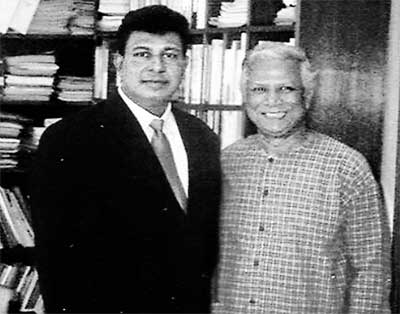
Nobel Peace prize winner visiting Lanka next weekProf. Muhammad Yunus, founder of the world-famous Grameen Bank and winner of the 2006 Nobel Peace Prize is visiting Sri Lanka next week from August 16 to 19 for a series of events.
Birth of micro credit In 1974 Prof. Muhammad Yunus, a Bangladeshi economist from Chittagong University, led his students on a field trip to a poor village. They interviewed a woman who made bamboo stools and learnt how costly it is to borrow money to buy raw bamboo for each stool made. After repaying the middleman sometimes at rates as high 10% week, she was left virtually penniless. Grameen Bank The response: “No we don’t have to. We know they don’t.” Faced with this hurdle, Prof Yunus offered the bank his services as a guarantor. He borrowed the money from the bank, loaned it to the poor and people paid it back. But the bankers were still insistent. “You are a fool. They will repay the money this time but the moment you loan more they will stop.” Prof. Yunus said the loans were repaid because the borrowers were all from one village where he had regular meetings. Grameen Bank (GB) was launched as an experimental project to combat rural poverty by providing credit to the very poor in 1983. It became established as a formal bank which provides small, collateral-free credit to poor rural folk mainly women, for income-generating activities. As of July 10, 2007, it has disbursed US$ 6,312 million to 7.21 million borrowers of which seven percent are women. With 2431 branches, GB provides services in 78,659 villages, covering more than 94 % of the total villages in Bangladesh. The loan recovery rate is 98.61%. An unusual feature of the Grameen Bank is that it is owned by the poor borrowers of the bank. They own 94% and the remaining 6% is held by the government. The bank has grown into over dozen enterprises represented by the Grameen Family -- Grameen Fund, Grameen Communication, Grameen Shakthi/Energy, Grameen shiksha/Education, Grameen Telecom, Grameen Motsho, Grameen Cybernet Ltd and Grameen Knitwear Ltd. Beggars programme The key features of this programme are unique and bypass the rules and regulations that apply to regular Grameen Bank members. These members are not required to form any micro credit group. While they may be affiliated with a regular group, they are not obliged to attend the weekly meetings. The regular group members act as mentors to the struggling members, providing guidance and support to them. The bank treats its struggling members with the same respect and attention as regular members and refrains from using the term "beggar" which is socially demeaning. A typical loan to a beggar member is US$ 9.00. It is collateral-free and there is no interest charged on it. The repayment schedule is flexible, decided by the struggling member herself. The installments are paid according to her convenience and earning capability, and must not be paid from money earned from begging. The goal of the programme is not only to economically empower but also to boost the morale and dignity of the beggars. They are given identity badges with the bank's logo as physical evidence of the bank's support behind them. For some of them Grameen Bank makes arrangements with local shops to give the members a credit line up to a given amount to pick up whatever items they choose to take out to sell in the village. The bank provides a guarantee to the shops that it will make payments in case of defaults. The struggling members sell items such as bread, candy, pickles, and toys, and so on to supplement their begging. The struggling members are welcomed to save with Grameen Bank as they wish. They are covered by the loan insurance scheme under which their loans will be fully repaid by Grameen Bank in case of death. In addition, US$ 9.00 will be provided from the bank's Emergency Fund to the bereaved family for meeting burial expenses. As of July, 2007, US$ 1.45 million has been disbursed to 83,829 struggling (beggars) members, of which US$ 0.94 million has been repaid. The writer is also director of the National Development Trust Fund of the Ministry of Finance. |
|
||
| || Front
Page | News
| Editorial
| Columns
| Sports
| Plus
| Financial
Times | International
| Mirror
| TV
Times | Funday Times|| |
| |
Copyright
2007 Wijeya
Newspapers Ltd.Colombo. Sri Lanka. |
